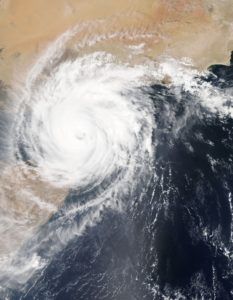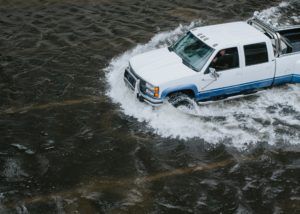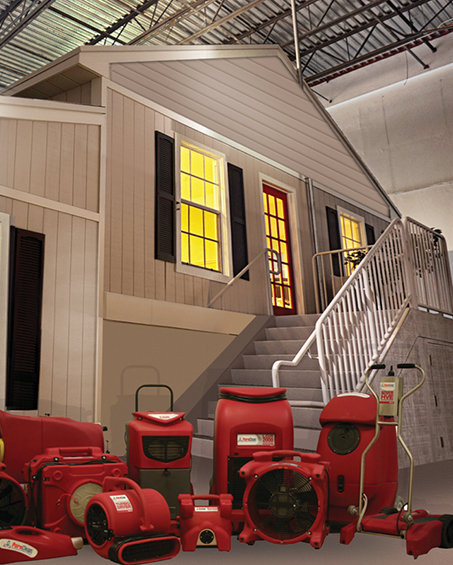Each September, the Federal Emergency Management Agency (FEMA) sponsors National Preparedness Month. This event reminds the public that disasters, both natural and man-made, can happen at any time both with and without warning. Heavy rain or flooding can not only cause water damage to your home, but can create a very dangerous situation for you and your family. In order to stay as safe as possible, FEMA suggests that every family have an emergency plan of action before disaster strikes.
The Importance of Being Prepared for an Emergency
 Since the turn of the century, the United States has seen quite a few major disasters. Hurricanes, flash floods, tornadoes, wildfires, earthquakes, and terror attacks have threatened and taken many lives. Almost 218 million people are impacted by these disasters each year, with another 99,000 losing their lives because of them.
Since the turn of the century, the United States has seen quite a few major disasters. Hurricanes, flash floods, tornadoes, wildfires, earthquakes, and terror attacks have threatened and taken many lives. Almost 218 million people are impacted by these disasters each year, with another 99,000 losing their lives because of them.
In some recent natural disasters, people have had little to no warning. But even with warning, not being prepared can be almost as disastrous as not having any sort of alert. In fact, in the event of a disaster, only half of American adults are properly prepared.
Be Prepared for Anything
In a disaster situation, you could be without power, phone service, transportation or medical help for several days. Local grocery and convenience stores may close due to damage or have limited stock if deliveries are unable to make it through impassable roads. Your town’s water supply could also be contaminated, which would leave you without access to safe drinking or bathing water.
When it comes to emergencies, anything can happen. Emergency preparedness prior to a disaster can lessen your reliance on first responders who may be unable to immediately reach you and your family. It also frees up emergency workers to help people who are in desperate need, whether it be because they are trapped or seriously injured. But most importantly, emergency preparedness could save the lives of you and your family.
How Should You Prepare?
 Part of being prepared is understanding which types of disasters are most likely to occur in your area. For example, in North Texas:
Part of being prepared is understanding which types of disasters are most likely to occur in your area. For example, in North Texas:
- Heavy rains can bring flooding
- Severe thunderstorms or weather disturbances can cause tornadoes
- Extremely hot weather can lead to extended power outages
- Snow or ice storms can shut down entire cities and cripple the metroplex
For proper emergency preparation for any disaster, you should plan to be without power and stuck in your home for at least three days. During those three days, you and your family will need:
- Food
- Water
- Shelter
- Sanitation
- First aid
In a best-case scenario, your emergency preparedness kit will never need to be used. But it’s best to have everything you need if disaster strikes and you don’t have much time.
Building an Emergency Preparedness Kit
Having an emergency preparedness kit for your family is important to keep them safe and as comfortable as possible during and after a disaster. It’s a good idea to have one kit for your home and one kit that can be easily transported in the event you must evacuate your home for several days. When packing your emergency kit, consider the needs of everyone in your family. Always take ages and dietary/medical needs into consideration when selecting items to take with you. And of course, don’t forget the needs of your furry friends.
 What You Need
What You Need
- At least 1 gallon of water for each person, per day. For example, if there are four people in your family, you should store at least 12 gallons of water. If you can store more water, do so to allow for washing, cleaning or preparing food.
- Non-perishable foods, including soups, beans, canned vegetables, dried fruit, meat jerkies, powdered milk and other foods with the goal of 2,000 calories per day, per person. (Don’t forget a manual can opener and pots to cook with!)
- Paper plates and disposable utensils
- A lighter or matches
- First-aid supplies, including bandages, antibiotic cream, ibuprofen/acetaminophen and splints
- Any prescription medications that your family may take, like insulin or heart medications
- Diapers, baby food and formula if you have infants or toddlers
- A battery-powered or hand-crank NOAA weather radio with extra batteries
- A knife and/or multi-tool
- Copies of your family’s important documents, including drivers’ licenses, birth certificates, social security cards, passports and marriage licenses
- Contact information for all family members, including extended family members, emergency services and emergency contacts
- Personal care items like toothbrushes, toothpaste, soap and shampoo
- Cash – ATMs may be out of service and stores or gas stations may be unable to process credit or debit cards
- Spare credit card
- Extra house and car keys
- Small toys, crayons and coloring books to keep young children entertained
- Food, water, and medications for your pets
All items should be stored in a waterproof container such as a plastic tote or waterproof duffle bag. Be sure to check your emergency-supply kit every six months to replace expired items.
Go Portable
It’s a good idea to have a portable emergency preparedness kit for your car or in the event that you need to grab it quickly and head out on foot. This kit should include cash, medications, water, blankets, a change of clothing and high-energy snacks like dried fruit, nuts, and granola.
What If You Have to Evacuate?
 For many disasters, unless there is an imminent threat to life and safety, your best bet is to shelter in place in your home if possible. If your home is in harm’s way, is severely damaged or you’re advised to evacuate the area by your local authorities, don’t forget to take your emergency supplies with you and get your family to a safe location.
For many disasters, unless there is an imminent threat to life and safety, your best bet is to shelter in place in your home if possible. If your home is in harm’s way, is severely damaged or you’re advised to evacuate the area by your local authorities, don’t forget to take your emergency supplies with you and get your family to a safe location.
Make a Plan
For most families, having to evacuate their homes may not be an easy task. You should have a plan in place before an emergency strikes so that your family understands what to do, especially if all are not home at the time of the evacuation:
- Make sure you and your family members are aware of specific evacuation routes. Know several alternate routes in case some roads are impassable.
- Designate an out-of-state family member or friend as your family’s contact person that can be contacted in case your family gets separated during an emergency.
- Advise family members to connect with the emergency contact if they become separated.
- Fuel up your vehicle when storm warnings have been issued and never allow your tank to be near empty at other times when you are home.
- Make plans for taking your pets with you. Some shelters will allow pets, but it’s best to have an alternate plan. You may need to stay in a hotel or at a friend or family member’s home out of the danger zone.
Secure Your Property
Before leaving your home, make sure you’ve done everything you can to secure your property. Put away lawn furniture or other outdoor items that can become dangerous flying objects in a storm. Unplug appliances and electronic items to protect them and your home from damage. Leave a note on your refrigerator or kitchen table that says you have evacuated your home. Be sure to note where you have evacuated to and how you can be contacted.
Learn More: 5 Ways to Help a Friend After a Natural Disaster
Proceed With Caution
 Once you receive the okay to return home, proceed with caution. You may encounter road damage, flooding, downed trees, or power lines. When you get home, immediately assess your house for damage, including your roof.
Once you receive the okay to return home, proceed with caution. You may encounter road damage, flooding, downed trees, or power lines. When you get home, immediately assess your house for damage, including your roof.
If water damage has occurred, you must act fast to prevent secondary damage from occurring. If you do not make a reasonable effort to prevent further damage, your insurer may not cover the secondary damage. Your best bet is to call the experts at PuroClean Restoration Specialists to perform your water mitigation and restoration, and work with your insurance company.



 PuroClean Restoration Specialists
PuroClean Restoration Specialists